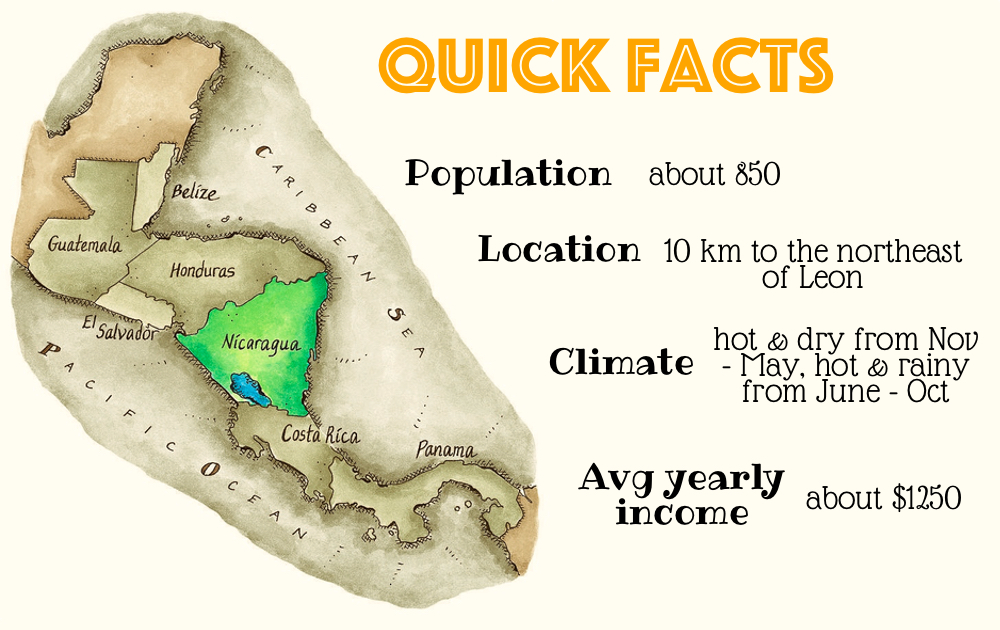
El Tololar is a small, poor and very kind community in the rural northeast of León, a hot, fertile valley ringed by volcanoes. The community is a loose collection of houses scattered between wide fields growing peanuts, corn, yucca and sesame seeds. El Tololar has a health center with a dedicated staff, a Catholic church, and a secondary school. The soil is dark volcanic sand, deposited by the 1996 eruption of the nearby volcano Cerro Negro.
The houses of El Tololar are built from cement and bricks, with zinc or tile roofs. Several poorer families live in ramshackle huts made of plastic and cardboard. Most people cook over open fires, but many families now also have refrigerators and gas ranges. Almost all families earn their living through agriculture, as planters, laborers and cattle herders.
El Tololar is a comarca of León; it is under the jurisdiction and responsibility of the mayor’s office in León. It is one of fourteen comarcas in this area, and there is an active organizational group made from representatives of each community, called the Red Territorial. It has strong ties with Zaragoza, in Spain, and with their help they have formed a number of cooperatives, improved the schools, and provided events and training for the community.
Tololar has around 120 families living in it, but the “around” connotes a wide margin of error due to amorphous boundaries, poor transient families, and houses so isolated that they are not clearly in one community or another. The area was hit very hard by Hurricane Mitch in 1998, which gouged out the paths and in some areas made them 15-20 feet deep. Erosion is a continual problem anyhow, since there are only fringes of trees around very wide fields, and the soil is so light and sandy.
Life in Tololar has the slow, gentle rhythm of the country; fires are lit and workers are out in the field by 5 a.m., working hard until 9 or 10, when everybody retreats to the shade for the hottest hours of the day. Crinkled old cowboys ride by on horses, plowing is still done by ox team, and the people are by and large wonderfully warm and hospitable.
However, Tololar is very close to the city of León, and so modernity and tradition coexist very closely. Most houses have televisions (a few now have satellite dishes), everybody has a cell phone, and motorcycles and refurbished Russian tractors rumble along the paths next to horses and cattle. One can go right from herding cattle and bareback riding to using the internet and enjoying a banano con leche in one of León’s chic cyber cafés. It is a funny juxtaposition, but can also be a very nice one.
CHALLENGES
Any resident over the age of 60 can tell you about a completely different Tololar. They always talk about the butterflies, the hundred varieties that bloomed every rainy season like wildflowers. They’ll reminisce of a Tololar full of trees, where lizards and birds were plentiful. They’ll recall that the rains came dependably around May 1st and lasted almost a month longer than they do today.
The Tololar of today is a very different place. It is largely deforested – most of the trees that remain are scrub trees used as living fences and windbreaks, or eucalyptus groves used as timber and firewood. There are fewer than twelve remaining individuals of the community’s namesake tree, the Tololo. Most of the land is given over to enormous peanut fields, which create terrible dust storms in the dry season.
Tololar’s ecological and economic problems are severe, but not insurmountable. Drip irrigation can put farmers back in control of their harvests, and substantially improve their economic circumstances. Reforestation efforts are helping to restore Tololar’s battered ecosystem. Education and empowerment can open new doors for young Tololareños, and help them to confidently take control of their community’s future.